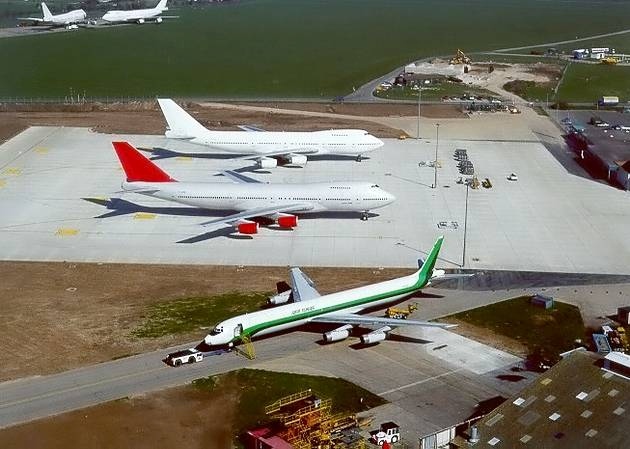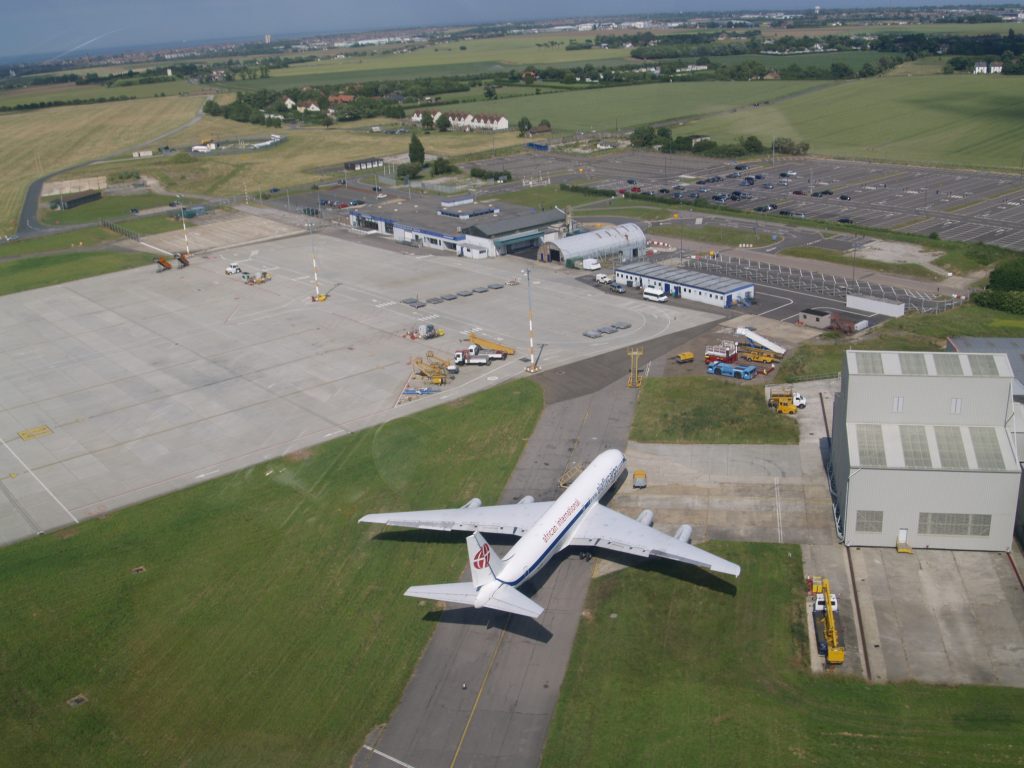Flying politician Lembit Öpik reviews the on-going dispute over the future of Manston Airport in South East England and outlines the strategic imperative for politicians to protect this vital resource.
It is hard to believe that the Government has been so slow at approving the third runway at Heathrow. Everybody who looks at the situation knows that, with aviation likely to expand at, say, 5% per annum, BOTH Heathrow and Gatwick will need more runway capacity in the foreseeable future. And still that is unlikely to be enough. What then?

Many years ago I used to fly to Manston Airport a lot. It took about 80 minutes in my Mooney M20J from Mid-Wales to Kent – and from a technical point of view it was a very interesting flight to make. The route requires really serious attention to detail, on account of the crowded airspace around London, plus unpredictable weather conditions along England’s east coast.
Manston itself was an awesome destination when viewed on final approach, with close to three kilometres of runway. It’s orientation has everything to do with World War II. Runway 28 was constructed to ensure that damaged, hard-to-manoeuvre bombers returning from sorties over enemy territory could land with a ‘straight-in approach,’ having plenty of space to find a way to land.
To be honest, my first landing at Manston did not take account of the breath-taking length of the runway: I had to sort of ‘take off’ again to speed along the centreline and expedite my exit. I’ve never doubted the aerodrome’s 2,748 metres when it comes to accommodating aircraft of any size.
That was some years ago. Sadly, at present only crows land at Manston. Regular operations are currently suspended, and the 800 acres of its territory lie eerily silent. Yet there is a strenuous campaign to rekindle major commercial operations involving both freight and passenger movements. There is also another campaign -by forces wanting to redeploy the land for housing, or other non-aviation use.
Why would such an important infrastructure resource be facing obliteration? The public discussion has centred on whether building development is a better use for the land than flying. A severe housing shortage exists in the South East. New developments are sold out within hours of coming on the market. Prices reflect this, and to put it right would require the construction of tens of thousands of new homes.
A nice, flat, well-drained airfield is highly attractive to developers. It’s much easier to construct buildings on a site which has already been tamed by decades of careful land management. Conversely, something as economically exotic as an airport carries with it all kinds of complexities and uncertainties, in a way that bricks and mortar don’t. With an airport people may come and fly: with a housing estate people WILL come and buy.
So, it’s time to face a home truth at the very heart of this debate; not just for Manston, but for the UK’s entire aviation infrastructure. An airport cannot be judged simply on the basis of what makes the most money in the least amount of time. If this were the only consideration, economics would lead to a change of use of just about every airport in the land.
Think of the revenues if you turned, say, 3,000 acres of attractively situated land in an urban locality into residential accommodation. At an average of 23 homes per acre, and assuming a typical home value for the area in question, this could generate house sale revenues of around £33 billion. I am , of course, referring to Heathrow Airport. Turning Heathrow into a housing estate would deliver around 12 times more revenue than the airport’s current annual turnover. With the construction of flats, those figures could be tripled – a circumstance in which the Council tax revenue alone matches the annual profit of the Airport.
Every other UK airport which I’ve looked at is even more vulnerable. Newcastle Airport, with an annual revenue of around £60 million, is worth 110 times its annual revenue in housing. That’s right, one hundred and ten times its current annual revenue if it were developed at an average housing density.
If making profit quickly is the key aim, I believe every airport in the UK is more attractive as a property development than as an aerodrome. Hardly surprising, then, that Manston, with its surface area of 800 acres, has developers straining at the leash to start building on it. And let’s be fair: the developers have no moral or financial responsibility to consider the macroeconomic or social implications to the region or the country of converting internationally significant travel hubs into lucrative property initiatives. And why should they? It’s not their job.
So, the inference is remarkably simple. No mainstream politician or businessperson doubts the central role of aviation in connecting large, modern nations with the rest of the world economically, culturally and socially. You only have to look at national planning around the EU and beyond to see that. Thus, in order to keep up in the shrinking global economy, especially in a post-Brexit environment, we’ve got to protect our aeronautical assets against the obvious attractions of a change of use.
Government must step up to its responsibilities here. If it cares about our position on the world stage, then politicians cannot sit back and merely ‘let the market decide’ – because the market will only decide one thing, and it’s not going to be flying. Ministers – and those in the Department for Transport in particular – have a moral responsibility to protect key assets of strategic importance to the long-term health of the economic and social evolution of the country. Manston is one of them.
Let’s test the figures. We can turn to proposals put forward by one group, Riveroak, which wants to re-open Manston for commercial aviation. They plan 500,000 tonnes of cargo and 2 million passengers within two years. Both these targets are many times higher than the previous best performance of the airport. What’s realistic?
The population of Kent is around 1.6 million – a little less than Northern Ireland. Yet between them, the two busiest airports there – Belfast International and Belfast Harbour – handle around 7 million passenger movements a year. At the same time, the City of Derry’s airport, at which only one carrier, Ryanair, operates scheduled services, handles 280,000 passengers – even though Derry’s population amounts to just 90,000. This is one example of many to prove that when you build airport facilities, the public will come. Manston doesn’t even have to be built – it’s already there. And it only has to achieve one quarter of the performance of Northern Ireland to make the Riveroak figures credible.

Even a more modest performance justifies retaining the facility. If 700,000 passengers passed through Manston, this would place it in roughly the middle of the league table of the top 40 UK airports. And to achieve that, it would only need one Airbus A320 to take off and land every two hours between 7am and 9pm. That’s around half the number of movements of Norwich Airport, and one sixth of the flights going in and out of Leeds/Bradford. It will still be operating at a significant level of activity, with potential to massively expand as the inevitable increase in air travel continues.
It’s worth noting that other factors drive Manston’s increasing viability in the longer term. With a credible and fairly simple plan to connect the airport with Central London by rail in a little over an hour, Manston is attractive to part of the Capital’s catchment too – especially on the east side. With two additional Thames crossings scheduled for construction – one centrally near Greenwich and the other to the East – there is even more reason to believe Manston will attract passengers, just as Stanstead and Luton do to the north.
These factors are not being properly taken into account. Without a holistic approach, Britain’s entire airport infrastructure is vulnerable to death by property development – a factor which has already claimed or threatened other smaller airports such as Teeside, Kemble and Leicester. Filton in Bristol, where exactly the same development has killed a fine facility, thanks to the perfect storm of a voracious appetite for fast returns in the property sector and a serious housing shortage facing town planners. Little wonder, then, that such peril faces Manston.
Government has to learn from the fastest growing economies in the world. China is currently expanding 60 airports, and opening 40 new ones between now and 2020 – that’s 10 new airports a year. They would consider it unthinkable to close an existing facility. To an extent they’re playing ‘catch up.’ But China has global ambitions, as do many other developing countries. Their investment will necessarily increase flights to the West. If we haven’t got space for them to land, they’ll leave their vapour trails above Britain and land on to the European continent. Whether in French, German or English, business is business.
Others seem to have grasped the need for international connectivity. Across Europe, there are over 230 airport developments, many of them straightforward expansions of existing facilities. I was unable to find any example of a country on the continent which is closing down any large airport facility. Indeed, in a European Commission report entitled ‘An aviation strategy for Europe,’ the entire focus is about ensuring an adequate infrastructure to manage growth. The narrative is about increasing airport capacity, not reducing it.
Tensions have been running high over Manston. MPs and local Councillors have promised to get the airport reopened. UKIP made it a key election pledge in recent local authority elections. In October 2016, senior Conservative Member of Parliament of 33 years’ standing, Sir Roger Gale, said he would retire from Parliament if the airport were not restored to operational status. The site has powerful allies, but the motivations on the other side can be measured in terms of a monumental financial opportunity plus that local housing shortage.
We live in an era when the free market is respected, and almost worshiped. Yet there has to be a time when Government intervenes to protect essential public resources that would otherwise be lost. However tempting it may be to build on flat, large and well-situated land, the reality is that there are other places the houses can go – for example, small additional developments in many locations which add manageable numbers of new residents – and turnover – to lots of village and town economies without creating a concentrated population spike – and traffic problems in one place. With a modicum of creative thinking, it’s a problem which can be solved without losing Manston.
With the airport, Kent and the South East of England can be international and global players. Without it, a vital component in the relationship between the South East, Britain and developing markets is. That’s why it’s time for politicians to step in and to facilitate a plan to make Manston the natural hub for new routes to and from developing markets. It is easy to add convenient passenger routes to connect the South East with feeder routes to regional airports – which removes some of the pressure from Heathrow and Gatwick, and creates many new business opportunities at the same time.
We should also include this obvious and attractive role for Manston as part of the UK’s intentional trade offering. When you look at it like that, it’s little short of scandalous that a private consortium is being left to defend and promote such a significant element in the country’s long-term infrastructure. After all, if China had an international airport less than an hour from the outskirts of its capital, they’d be hard at work investing in the future, guaranteeing it remained open for business.
The effects or abandoning this ready-made international airport would only become fully evident in the longer term. But failing to ensure Manston reopens for passenger and freight operations would represent an act of strategic self-harm for the county, suggesting Government really doesn’t grasp the central contribution of aviation to the UK’s status on the international stage.







